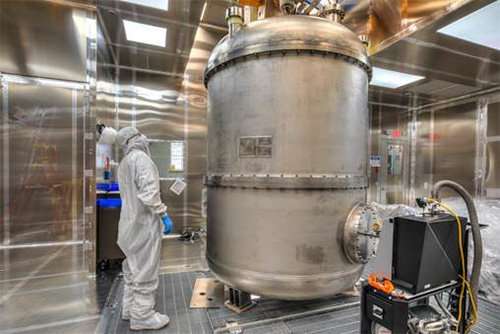UK delivers super-cool kit to USA for Next-Generation Dark Matter Experiment

A huge U.K.-built titanium chamber designed to keep its contents at a cool -100C and weighing as much as an SUV has been shipped to the United States, where it will soon become part of a next-generation dark matter detector to hunt for the long-theorised elusive dark matter particle called a WIMP (Weakly Interacting Massive Particle).
This hunt is important because the nature of dark matter, which physicists describe as the invisible component or 'missing mass' in the universe, has eluded scientists since its existence was deduced by Swiss astronomer Fritz Zwicky in 1933. The quest to find out what dark matter is made of, or whether it can be explained by tweaking the known laws of physics, is considered one of the most pressing questions in particle physics, on a par with the previous hunt for the Higgs boson.
The cryostat chamber was built by a team of engineers at the UK's Science and Technology Facilities Council's Rutherford Appleton Laboratory in Oxfordshire, and journeyed around the world to the LUX-Zeplin (LZ) experiment, located 1400m underground at the Sanford Underground Research Facility (SURF) in South Dakota.
After being delivered to the surface facility at SURF the Outer Cryostat Vessel (OCV) of the cryostat chamber spent five weeks being fully assembled and leak checked in the SURF Assembly Lab (SAL) clean room. It has now been disassembled and packaged for transportation from the surface to the underground location at SURF. Meanwhile the Inner Cryostat Vessel is now in the SAL clean room getting prepared for the leak tests.
STFC's Dr. Pawel Majewski, technical lead for the cryostat, said: "The cryostat was a feat of engineering with some very stringent and challenging requirements to meet. Because of the huge mass of the cryostat – 2,000kgs – we had to make sure it was made of ultra radio-pure titanium. It took nearly two years to find a pure enough sample to work with. Eventually we got it from one of the world's leading titanium suppliers in the US where Electron Beam Cold Heart technology was used to melt the titanium.
"This type of ultra-pure titanium is used, for example, in the healthcare industry to fabricate a pacemaker encapsulation. In our case it is used to hold the heart of the experiment."
It took two-and-a-half years to design the specialist equipment, and another two years to build in Italy by a company specialising in vessels and pipes fabrication only from titanium.
The cryostat is a vital part of LZ, as it keeps the detector at freezing temperatures. This is crucial because the detector uses xenon – which at room temperature is a gas. But for the experiment to work, the xenon, which itself has low background radiation, must be kept in a liquid state, which is only achievable at around -100C.
LZ is the latest experiment to hunt for the long-theorised elusive dark matter particle called a WIMP (Weakly Interacting Massive Particle). Many scientists believe finding WIMPs will provide the answer to one of the most pressing questions in physics – what is dark matter? WIMPS are thought to make up the most of dark matter – the as-yet-unknown substance which makes up about 85% of the universe. But because WIMPs are thought not to interact with normal matter, they are practically invisible using traditional detection methods.
Liquid xenon emits a flash of light when struck by a particle, and this light can be detected by very sensitive photon detectors called photomultiplier tubes. If a WIMP collides with a xenon nucleus we expect it to produce a burst of light.
Before delivery to SURF the cryostat underwent several weeks of rigorous testing and a month-long thorough clean from an expert cleaning company in California. Five years after the design efforts started, the cryostat arrived safely at SURF and the LZ team then carefully unwrapped it and put it into place.
"It's a great experience to see all of the planning for LZ paying off with the arrival of components," said Murdock "Gil" Gilchriese, LZ project director and a Berkeley Lab physicist. "We look forward to seeing these components fully assembled and installed underground in preparation for the start of LZ science."
UK PI for LZ is Professor Henrique Araujo from Imperial College London and he said: "It is incredibly gratifying to see LZ beginning to take shape. Seeing the cryostat arrive is a milestone moment as it has been years in the making.
"Now we have to wait for the other constituent elements to arrive before we can start to see some exciting science taking place at this ground-breaking facility."
LZ will be at least 100 times more sensitive to finding signals from dark matter particles than its predecessor, the Large Underground Xenon experiment (LUX). The new experiment will use 10 metric tons of ultra-purified liquid xenon, to tease out possible dark matter signals. Xenon, in its gas form, is one of the rarest elements in Earth's atmosphere
Although this is a major milestone for the experiment, there are still many components yet to be assembled and tested. Upgrades of the underground Davis cavern at SURF, where LZ will be installed, are in progress and will be completed by August and large acrylic tanks that will help to validate LZ measurements are expected to arrive at SURF by September. It is currently expected that the experiment will start taking data in 2020.
Provided by Science and Technology Facilities Council



















